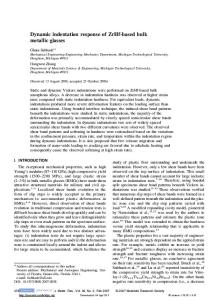Correlation Between Dynamic Compressive Strength and Fracture Behaviors of Bulk Metallic Glasses
- PDF / 2,190,476 Bytes
- 9 Pages / 595.276 x 790.866 pts Page_size
- 49 Downloads / 352 Views
Correlation Between Dynamic Compressive Strength and Fracture Behaviors of Bulk Metallic Glasses Wenqing Li1,2 · Zhengwang Zhu1 · Guojie Li3 · Long Zhang1 · Zhengkun Li1 · Huameng Fu1 · Hongwei Zhang1 · Hong Li1 · Aimin Wang1 · Haifeng Zhang1 Received: 8 February 2020 / Revised: 19 March 2020 © The Chinese Society for Metals (CSM) and Springer-Verlag GmbH Germany, part of Springer Nature 2020
Abstract The mechanical behaviors of Zr43.5Cu43.5Ni4Al8Nb1, Zr55.4Cu31.6Ni4Al8Nb1, Ti32.8Zr30.2Ni5.3Cu9Be22.7 (at.%) metallic glass at different strain rates were studied. For all the present alloys, the dispersion over 700 MPa was observed on the strength in the repeated dynamic compressions, which was much stronger than that of the quasi-static compressive strength. Such the dispersion of the dynamic compressive strength was well correlated with the corresponding fracture behaviors. The area of fracture surface was calculated and also showed a strong dispersion for all the fractured specimens tested at the strain rate of 500 s−1 and 1000 s−1. All the specimens showed a linear relationship between the square of dynamic compressive strength and the area of fracture surface in the dynamic compression tests. This phenomenon was mainly thought to be related to the difference of mean initial free volume concentration of different samples, stress concentration caused by the split Hopkinson pressure bar experimental setup and high sensitivity of defects under dynamic deformation. These findings were beneficial to deeply understand the effect of strain rate on the mechanical properties of the metallic glass. Keywords Metallic glass · Dynamic compression · Weibull statistics · Shear bands
1 Introduction Bulk metallic glasses (BMGs) have attracted increasing attention because of their superior mechanical, physical, chemical and biological properties, etc. [1–5]. High mechanical performance including high strength, high elastic limit and high toughness, etc., makes BMGs and BMG matrix composites potentially prosperous engineering structural materials [1, 4], especially in some impacting events, i.e., Available online at http://link.springer.com/journal/40195. * Zhengwang Zhu [email protected] * Haifeng Zhang [email protected] 1
Shenyang National Laboratory for Materials Science, Institute of Metal Research, Chinese Academy of Sciences, Shenyang 110016, China
2
School of Materials Science and Engineering, University of Science and Technology of China, Hefei 230026, China
3
Beijing Institute of Space Long March Vehicle, Beijing 10076, China
defense, aerospace and micro-electro-mechanical system (MEMS) fields [6–9]. Accordingly, it is urgent to recognize the deformation behaviors at high strain rate and figure out the underlying mechanism for promoting BMGs practical applications and developing new BMG materials with the optimized performance. Many works have devoted to exploring the dynamic mechanical behaviors of BMG materials [10–12]. The effects of the strain rate [13–16], aspect ratio (i.e., L/D) [17–19], loading
Data Loading...











